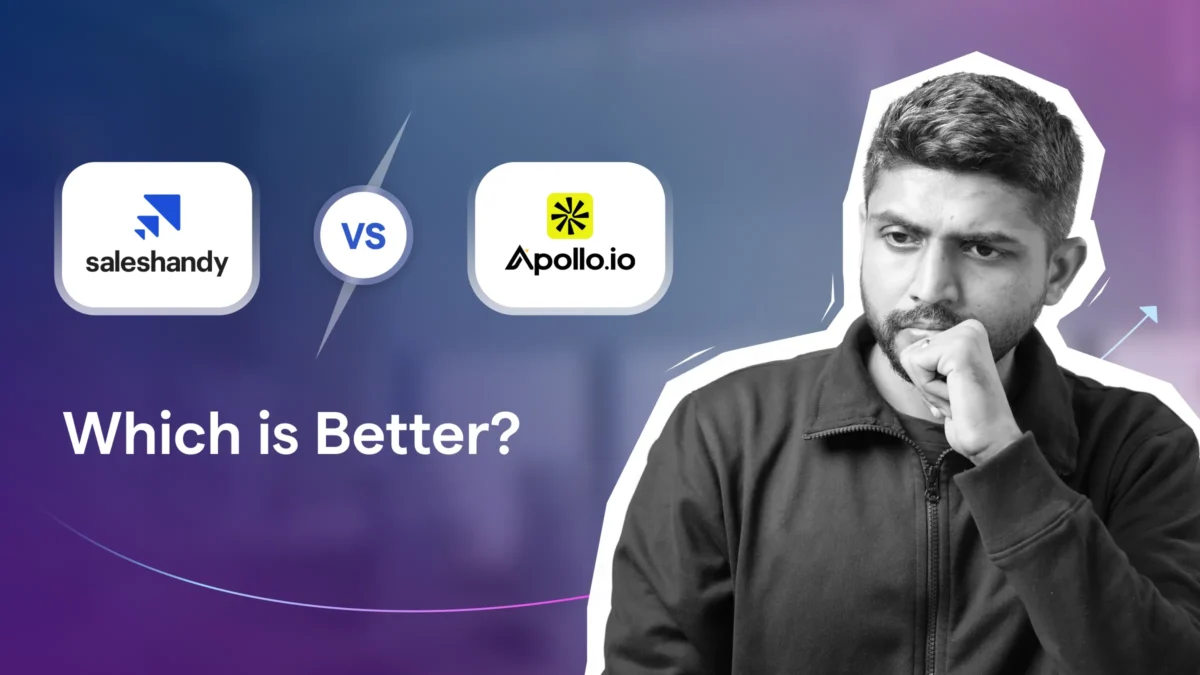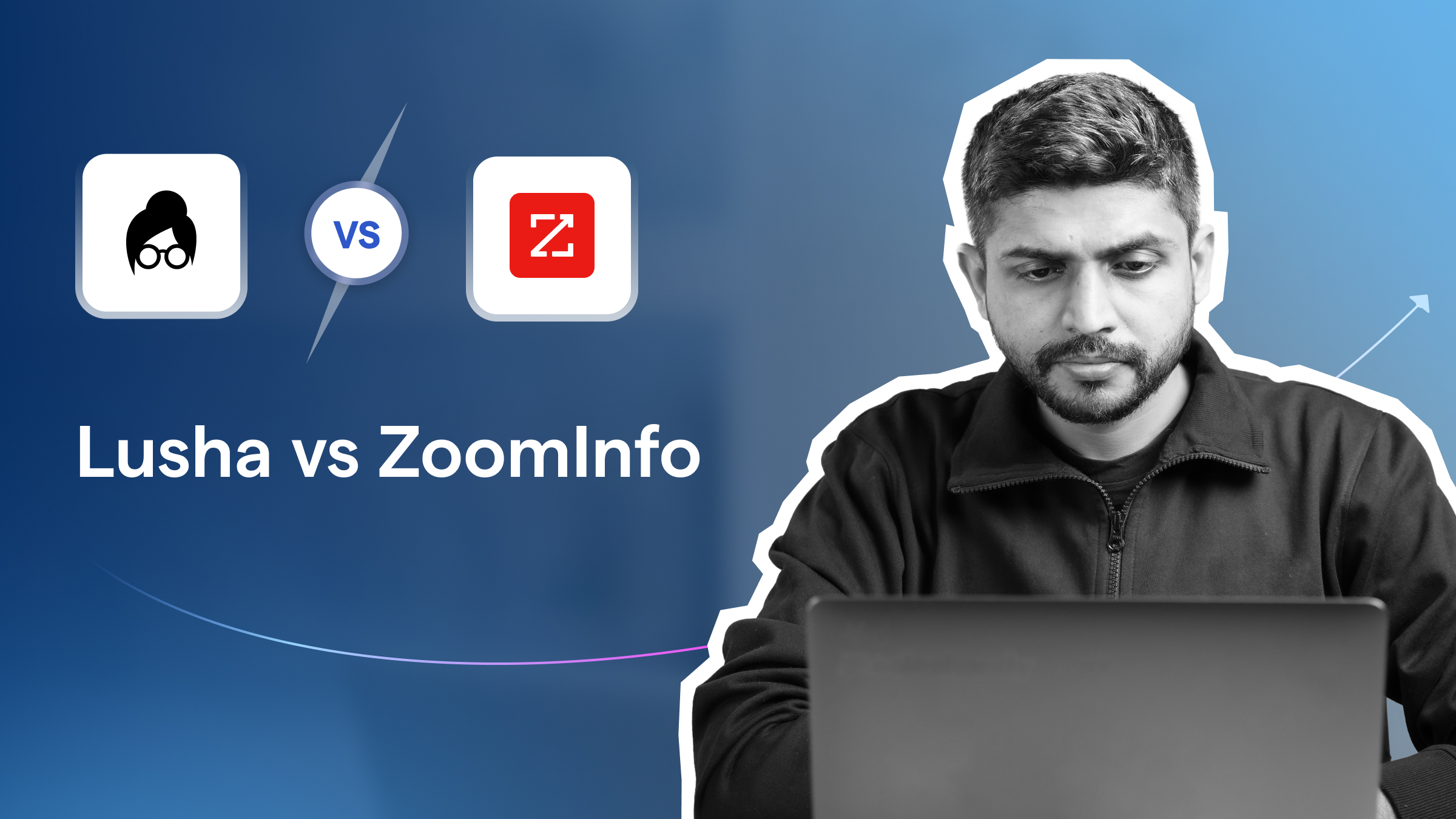Contents
- 1 Saleshandy vs Apollo.io – TOC
- 2 Quick Comparison of Saleshandy & Apollo
- 3 Apollo Vs. Saleshandy Feature Comparison
- 3.1 B2B Database Comparison: Saleshandy or Apollo?
- 3.2 Sequence Automation Comparison
- 3.3 Comparison of Personalization Options
- 3.4 Comparison of Email Warm-Up & Deliverability Stack
- 3.5 Reply Management Comparison
- 3.6 Features for Agencies Comparison
- 3.7 Integrations Comparison
- 3.8 Whose Customer Support Is Better?
- 4 Saleshandy Vs. Apollo: Pricing Comparison
- 5 Saleshandy vs. Apollo: And The Winner Is
- 6 FAQs
If choosing between Apollo and Saleshandy feels confusing, you’re not alone.
Apollo’s huge database and “all-in-one” vibe make it look like the obvious choice at first look.
But once you start running sequences, things get messy:
- Emails miss inboxes.
- Bounce rates increase.
- Reply rates drop.
You start wondering whether it’s your copy, your domain… or the tool itself.
That’s exactly why this comparison exists.
Not to pick sides, but to show what actually impacts your outbound.
Let’s break down where Apollo shines, where it struggles, and where Saleshandy does things differently.
Saleshandy vs Apollo.io – TOC
Quick Comparison of Saleshandy & Apollo
Here’s a fast overview so you can immediately see where each platform stands. I have compared the major deciding factors side by side.
| Feature | Apollo.io | Saleshandy |
|---|---|---|
| Pricing | $49/month | $25/month |
| B2B Contact Database | Mid-size data (275M+) with mixed accuracy | 700M+ verified outreach-ready contacts |
| Email Sequence Automation | Advanced but complex UI | Intuitive sequence builder |
| Personalization | Standard field-based personalization | Deep merge tags & AI personalization |
| Email Warm-Up & Deliverability | Email warm-up available | Inbox deliverability tests with unlimited email warm-ups |
| Reply Management | Basic reply management | Smart auto-labeling & AI categorization |
| Agency Features | Not built for agencies | Multi-account workspace setup |
Apollo Vs. Saleshandy Feature Comparison
I’m not here to throw a biased “X is better than Y” statement at you.
Because both tools can work, depending on what you need.
So let’s walk through each feature one by one and see how they stack up in actual use cases.
- B2B Database
- Sequence Automation
- Personalization
- Email Warm-Up & Deliverability Stack
- Reply Management
- Features for Agencies
- Integrations
- Customer Support
B2B Database Comparison: Saleshandy or Apollo?
When it comes to outbound, your results are only as good as the data you start with.
That’s why the B2B database is where the Apollo vs. Saleshandy comparison really begins.
Now, Apollo.io is quite well-known for its database. You can filter by industry, company size, title, and more.
It has a pool of 275M+ contacts from over 35M companies.

Also, Apollo provides data enrichment, where you can enhance your existing records.
And you can even set up job change alerts (which is great for recruiters).

But it all sounds impressive on paper.
The problem? Popularity doesn’t always equal quality.
If you check Reddit threads or G2 reviews, you’ll notice a pattern.
The users love Apollo’s coverage but often mention data accuracy issues.
And in some cases, they also mentioned a sudden spike in bounce rates when running large-scale campaigns.
Now, in comparison to Apollo, Saleshandy has a bigger database (around 700M+ verified contacts).

I got in touch with some ex-Apollo users (who are using Saleshandy now).
According to them, Saleshandy’s database is more accurate.
And for all the right reasons, because Saleshandy Lead Finder verifies data in real time.
Also, Saleshandy has an AI Lead Search feature.
So, all you need to do is give a prompt, and it will find prospects based on your needs.
Verdict:
So, while Apollo might look like a people’s choice, Saleshandy wins on data reliability.
The reason is simple. If you get clean and “ready for outreach” data, then it saves a lot of your time.
Hence, Saleshandy is the smarter choice.
Check out our blog for detailed review on Saleshandy.
Sequence Automation Comparison
Once you’ve got the right leads, the next question is: how do you reach them consistently?
That’s where email sequence automation comes in.
For that, Apollo.io gives you a decent sequence builder with multi-step, multichannel workflows.

You can combine emails, LinkedIn tasks, and even calls in a single sequence.
This is great for enterprise teams running complex outreach motions.
But here’s the catch: it feels heavy.
The interface is packed with options, filters, and steps that can quickly overwhelm smaller teams or solo reps.
You’ll need to invest time in setup and learning before you can really automate at scale.
Saleshandy, on the other hand, keeps things refreshingly simple.
In fact, its email sequencing tool is built with deliverability and usability in mind.

You can easily create condition follow-ups with multichannel tasks.
Plus, every campaign automatically aligns with best sending practices.
The best part: You can create a whole sequence with AI Sequence Copilot.
It will understand your audience based on your website and create messaging around it.
Also, their Sequene Score feature analyzes your emails and gives you suggestions to improve them.

Verdict:
Here, Saleshandy and Apollo tie out when it comes to the features.
However, if you want a tool that allows you to launch sequences quickly with clean deliverability, then Saleshandy wins hands down.
Comparison of Personalization Options
Everyone talks about personalization, but very few tools make it easy to actually do it at scale.
Why? Because you want context-rich, natural-sounding emails even when automated.
Apollo.io does a decent job here. It lets you add dynamic variables, merge tags, and even conditional logic for different prospect segments.

So yes, you can tailor your sequences based on role, industry, or company type.
But in practice, the editor feels a bit… mechanical.
Once your campaigns get larger, double-checking how each email looks for different recipients becomes a pain.
Saleshandy focuses on clarity and control.
Its personalization engine is off the charts.
Why? Because Saleshandy has just launched AI Prospect Enrichment.
Where you can use AI to find latest information about any prospect.
This way, you can personalize your email with better context.
This way, your emails will sound differently from the first touch.

Also, you can create multiple AI Variants to A/B test your email copies.
Plus, when paired with Saleshandy’s deliverability stack, these personalized emails land in inboxes like real human messages.
Verdict:
Apollo has more data points to personalize from. But the experience can feel clunky at scale.
Saleshandy keeps it simple and intuitive. It gives you the flexibility to personalize smarter.
If your goal is to make every cold email feel like a one-on-one conversation, Saleshandy does that better.
If you’re considering Apollo, check out this detailed review of Apollo.
Comparison of Email Warm-Up & Deliverability Stack
If you are comparing Saleshandy and Apollo. You know how important deliverability is.
The thing is, Apollo.io has recently launched its email warm-up feature.

It is still new, and not many have tried it out.
But from my experience, it is decent and can work for your campaigns.
The only good thing is that they are not charging separately for the warm-up feature.
But it’s still early to judge. Because many times when a new feature is launched, it’s not that great.
Saleshandy, on the other hand, has a well-developed email warm-up option at no extra cost.
You can automate warm-up for all your inboxes while keeping track of progress.

Also, you can run Inbox Placement Tests in Saleshandy.
It will actually help you check how many of your emails land in inboxes and spam folders.
This way, you can prepare your email infrastructure for better performance.
Verdict:
When it comes to warm-up and deliverability, Saleshandy has an advantage.
It gives more options for users to perfect their email infra deliverability with warmups and inbox placement tests.
This ensures that every campaign lands safely in the recipient’s inbox.
Useful resource: Top Apollo.io Alternatives.
Reply Management Comparison
When you’re running multiple campaigns or managing multiple inboxes.
Reply management becomes a big differentiator between outreach tools.
Apollo.io does give you basic reply tracking, but that’s pretty much where it ends.
Replies are treated like simple inbox responses.
No smart categorization or no automatic labeling.
Basically no easy way to know which replies are positive, negative, or out-of-office.
If your outreach volume increases, keeping track of all these manually would eventually become difficult.
Now, when it comes to Saleshandy, you can manage replies more intelligently.
It automatically detects and labels replies so you instantly know which responses need attention.

This means you don’t wake up to a wall of messages with no idea where to start — your inbox is already pre-sorted for you.
And if you’re running outreach as part of a team, Saleshandy’s shared inbox visibility makes collaboration easy.
Everyone can monitor replies and never lose track of a hot lead again.
It’s a clean, efficient system that helps you respond faster. Which directly impacts conversions.
Verdict:
Apollo helps you check and respond to replies.
Saleshandy helps you manage them properly.
If you want reply handling that feels organized and built for high-volume cold email. Saleshandy clearly wins this round.
Features for Agencies Comparison
Agencies run outreach very differently from individual sales reps or small teams.
And the last thing you need is a tool that makes you jump through hoops just to manage them.
This is where the gap between Saleshandy and Apollo starts to widen.
Apollo.io is built primarily for internal sales teams.
Yes, you can manage multiple sequences and accounts, but it’s not designed for client-based outreach.
You don’t get isolated workspaces or any method to separate client campaigns.
Everything exists under one big umbrella, which quickly becomes chaotic if you have several campaigns running for different clients.
Many agencies using Apollo end up creating separate logins, separate CRMs, or separate folders just to keep campaigns from mixing…
Which is not ideal when you’re managing paying customers.
Saleshandy, on the other hand, is built with agencies in mind.
You get:
- Whitelabeling
- Multi-client account management
- Unlimited Email Accounts (at no additional cost)
- Agency-Level Reporting
- Client Access (Sharing Campaigns/Reports)
- Team Collaboration & User Roles
It’s basically everything an agency needs to run cold email at scale.

If you work with multiple clients, this structure alone saves hours every week.
And this also helps you avoid costly mistakes like sending Client A’s email from Client B’s domain.
(Yes, it happens all the time with tools not built for agencies)
Verdict:
Apollo can work for agencies, but it’s not built with them in mind.
Saleshandy is designed specifically to handle multi-client outreach.
Integrations Comparison
This is another area where the philosophies of Apollo and Saleshandy differ.
Apollo.io comes with a decent list of integrations.
It has an option to connect with CRMs, dialers, and enrichment tools.
Here’s a list of integrations Apollo provides:
- Hubspot
- Pipedrive
- Salesforce
- SalesLoft
- SendGrid
- Mailgun
- Zapier
But here’s the nuance most people miss.
Apollo tries to be an “all-in-one” platform.
But a lot of teams end up using fewer integrations than expected.
Not because they don’t want to, but because the setup is a bit much.
Saleshandy keeps things straightforward.
It integrates with,
- Pipedrive
- HubSpot
- Zoho
- Salesforce
- Zapier
- Persana
And more…
Basically everything you need to run cold email without bloating the system.
This simplicity is intentional.
And since Saleshandy focuses on cold email + deliverability rather than becoming an all-in-one monster, its integrations are cleaner, faster, and easier to maintain long-term.
Verdict:
Apollo wins on the quantity of integrations.
Saleshandy wins on ease and practicality.
If you want a simple, reliable workflow that plugs into your existing stack without complexity, Saleshandy is the smoother experience.
Whose Customer Support Is Better?
This is one area people underestimate… until something breaks.
Because things go south, you want answers fast.
And this is exactly where Saleshandy and Apollo differ more than most people think.
Let’s start with Apollo.io.
Apollo has a massive user base. And with big platforms, support usually becomes… well, big-platform support.
They have documentation, tutorials, and a help center that covers the basics. All good.
But when something actually goes wrong?
Here’s the pattern you’ll notice if you read through Reddit threads or G2 reviews:
- Responses can be slow during peak hours
- Issues get escalated, but not always resolved quickly
- For technical bottlenecks, you often get a link instead of a fix
- Wait times increase as your issue becomes “more complex”
And it’s not because Apollo doesn’t care.
It’s because large, multifaceted platforms naturally introduce more complexity.
Now, compare that to Saleshandy.
Saleshandy follows a different approach. It’s smaller, more focused, and more hands-on with users.
This makes their support experience feel… human.
Here’s what I mean:
- Live chat actually replies fast
- They walk you through the steps
- Deliverability questions get proper answers (not something like “check your DNS” responses)
- They help you fix issues instead of diagnosing them and leaving you hanging
And if you’re an agency (or sending from multiple client accounts), this becomes even more important.
Because when one inbox faces issues, the whole campaign slows down.
A quick fix can literally save revenue.
I also talked to a few users who migrated from Apollo to Saleshandy.
And their feedback was pretty consistent:
“With Apollo, I’d wait half a day for answers. With Saleshandy, I get help within minutes.”
Verdict
Apollo’s support is functional and documentation-rich. But not fast.
Saleshandy’s support is faster, more practical, and more hands-on.
If quick, human, problem-solving support matters to you (and it should), Saleshandy clearly wins this round.
Saleshandy Vs. Apollo: Pricing Comparison
After comparing all the features, now let’s talk about pricing.
Apollo’s paid pricing starts from $49 per month (Basic plan). Why is quite costly for small businesses.
And it has a credit-based system. With that, it provides 2500 credits in the basic plan.
But the credits charged for every action is different.
For example,
- 1 email = 1 credit
- 1 phone number = 8 credits
Which is way costlier than what Saleshandy charges.
Saleshandy’s basic plan starts at $25. Which is quite budget-friendly in comparison to Apollo.
Also, you get to add unlimited email accounts with free email warm-up.
Saleshandy vs. Apollo: And The Winner Is
If I were to summarize.
Then, if you want your overall campaign to work out, you should use Saleshandy over Apollo.
Otherwise, both Saleshandy and Apollo are solid.
It is just that they are built for different types of teams and different stages of growth.
So who actually wins?
Well… it depends on what you’re optimizing for.
Saleshandy = clean, predictable, and fast.
Apollo = big, complex, and powerful.
FAQs
1. Which tool is more beginner-friendly?
Saleshandy. The UI is cleaner, the setup is faster, and pricing is easier to understand. Apollo can feel overwhelming for beginners because of its feature depth and credit system.
2. Which tool is more affordable?
Saleshandy. It has flat, transparent pricing with no credit add-ons. Apollo can become expensive once you scale prospecting or need more credits.
3. Which tool is better for agencies?
Saleshandy, because multi-account management, deliverability stack, client separation, and predictable pricing make it easier to scale safely.
4. Should I switch from Apollo to Saleshandy?
Switch if you want:
- predictable pricing
- verified contacts
- cleaner outreach workflows
- better deliverability







